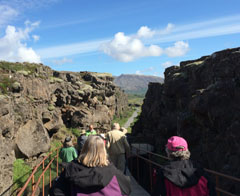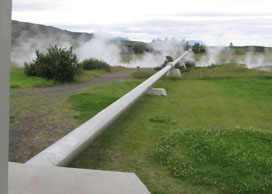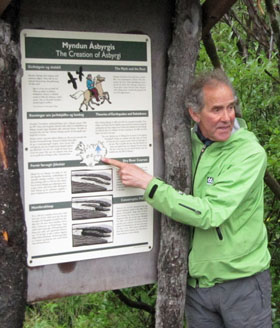 Margie and I returned two days ago from a tour of Iceland, a very unique country. While linguistic digressions are commonplace in my blog entries, it's unusual for me to initiate one in my second sentence. But I feel I need to say something about the phrase "very unique". If you want to read it now, take a look at footnote 1. Or read it later. Or ignore it altogether. In any event, Iceland is unique in many dimensions:
The picture to the left shows our group walking through a rift created by this spreading. On one side is the North American plate, and on the other side the Eurasian plate. Our daughter Sara joined us on this tour, which was organized by MIT alumni travel. She wrote blog entries all during the trip, posting them on her Innovation on Earth blog, which she maintains primarily for the benefit of her students (she's a middle school teacher). Sara was writing and posting her blog entries most evenings while Margie and I were collapsing into our beds after each long, active day. Well, she's young. I'll include links to a few specific blog entries of Sara's in case you want to see more photos. The photo above was taken from her entry entitled The Slow and Sudden Movements of Iceland. These entries generally also include short video clips. I won't link to all her entries here, but if you go to the Iceland category of her blog, you can see the full set. Because this was an MIT tour, we were also accompanied by Professor Thomas Herring. He's an expert in making highly accurate measurements of the positions of points on the earth, and gave us a lecture on the subject during our trip. He was also always available to answer questions along the way. Dimension 2: Because of the way Iceland was formed, it was never a part of the supercontinent Pangaea. Thus there can be no flora or fauna on Iceland unless it was imported in some way. Birds, of course, can fly there, and they often bring seeds with them, so the plant life is reasonably diverse. But there are relatively few animals other than birds, because they had to have been somehow brought in. Imagine a country without squirrels or chipmunks, or in fact with hardly any small mammals at all. There are no reptiles or amphibians - no frogs, toads, or lizards. Humans have brought in horses, cattle and sheep, dogs and cats, and, actually, foxes and mink (the last having been imported for their fur, and of course, some of them escaped and started breeding in the wild).
You can see many more photos of our puffin excursion in Sara's blog entry Why Only Puffins?
We were told that in the winter, the farmers go out to round up their sheep, which can be many kilometers away from where they started. I asked our guide how they know which sheep are theirs, and he replied, "Oh, a farmer knows his sheep." I'm not sure whether he was joking or not. I assume that the sheep may have some sort of identifying ear tag. Like the sheep, Icelandic horses are also a distinct breed, shorter and stockier than our horses. Dimension 3: Iceland has lots and lots of inexpensive energy. Because of the way it was formed, (and continues to be formed), there is a hotbed of volcanic activity below Iceland, and in many places it's not very far beneath the surface. There are a number of active volcanoes, which periodically erupt, and in many places, hot water or steam simply flow out of the ground.
Iceland makes active use of all this free energy. Most countries depend on petroleum or coal for energy, but Iceland uses petroleum only for airplanes, boats, and cars. Heat and electricity cost almost nothing in Iceland. Icelandic experts have been helping Japan develop their own geothermal power. The source of the underground heat is different in the two countries, however. In Iceland, magma is rising up from under the ground. Japan, on the so-called "Ring of Fire", is over a "subduction zone", where one tectonic plate is pushing under another. For many other photos and videos, see Sara's blog entry Power Underground Iceland. Dimension 4: Iceland was populated largely by Vikings, and because of its isolation, it's got a very small genetic pool. There's a cell phone app to determine whether someone you're thinking of dating might turn out to be your first cousin. Due to the inbred population, Iceland is frequently used for genetic studies. The population is still small; there are less than 330,000 people in the entire country. Dimension 5: Iceland has its own, ancient language, Icelandic, by some definitions one of the oldest Indo-European languages (Lithuanian is older). It's a Nordic language, related to Norwegian, Danish, and Swedish. That means it's in the North Germanic branch of the Indo-European language family.
By the way, Steingrímur goes by the nickname "Steini", pronounced like the pair of English words "STAY-knee". I took the photo to the left as he introduced us to the geology of Asbyrgi canyon, essentially a dry waterfall. For Sara's blog on Icelandic waterfalls, see Waterfall Pageant (with lots of pictures and videos). At the head of the canyon, we happened across a Spanish-speaking tourist group. Steini instructed the group, in Spanish, on how to deliver a hearty Icelandic yell, so we could hear it echo in the canyon. Here's an example of how I began to understand fragments of Icelandic. I came across an advertising poster on a wall with a three word Icelandic phrase, and an English translation under it. The first word in the Icelandic sentence was "Þin", and the first word in the English sentence was "Your" (sorry, I didn't get a picture of it). The first character in the Icelandic word is a letter called "thorn", and it's pronounced like an English "th". Having learned from Steini, I was able to relate the Icelandic word "Þin" to the old English "thine". Icelandic was beginning to make sense to me. So in addition to the fascinating scenery, the myriad waterfalls, the geothermal power, and don't forget the sheep, part of the fascination of this trip for me was linguistic. As Polonius said in Hamlet, "This above all: to thine own self be true." I primarily study the Latin-based "Romance" languages French, Spanish, and Italian, and at the outset of the trip, I didn't expect to learn much about the Germanic language Icelandic. But I was in for a surprise. I may now try to study more about the history of the Germanic branch of the Indo-European language family, which is, after all, the family to which my own language, English, belongs. Some of the special characters in the Icelandic alphabet are eth (ð), capital eth Ð, thorn (þ), capital thorn, (Þ), the ae ligature (æ), and its capital version (Æ). Accent marks can also be used over many of the vowels, changing their sound. In Iceland, essentially everyone speaks English, except small children. Everyone learns English in school, starting at about the age of seven. In general, when traveling in a foreign country whose language I don't speak, I wouldn't just start speaking to someone in English without first inquiring as to whether or not they speak it. But in Iceland, this standard preamble is not necessary. In fact, some of the Icelanders seemed to find it a bit insulting - of course they speak English. This is not surprising in a country in which your own language is absolutely useless as soon as you set foot outside its borders. This is true of all the Scandinavian countries, in fact. Danish, for example is pretty much useless outside of Denmark. Use of English by the Finns is generally so excellent that I've occasionally taken Finnish citizens for British. So consider a country with an area (103,001 square kilometers) slightly smaller than the US state of Kentucky. The population is highly homogeneous, and everyone speaks a language spoken almost nowhere else in the world (a very small number of people living in Denmark, about 8,000 people, also speak Icelandic). They face regular volcanic eruptions, and frequent earthquakes, which are also caused by underground thermal activity. It's not surprising that the people stick together, and that the whole country feels a bit like one very large family.   Note 1: Linguistic purists frequently complain that it's not possible to qualify the word "unique". Since "unique" means "one-of-a-kind", how can anything be more unique than anything else? But thinking about it, I'm not sure I agree. As I recall reading, I think on a T-shirt, "Remember that you're unique. Just like everybody else." Indeed. Obviously, every country is unique. Each country has various attributes, strengths and weaknesses, that distinguish it from others. But Iceland possesses enormous distinctions, along many more dimensions, than most other countries. It strikes me that it is meaningful to say, "Iceland is very unique." Also, people do qualify the word "unique" in various ways, and their listeners understand what they mean. I don't think I can go with the grammar purists on this one. [return to text] Note 2:
The sheep photo was taken from the Internet under a Creative Commons Attribution 2.0 Generic license. [return to text]
 |




